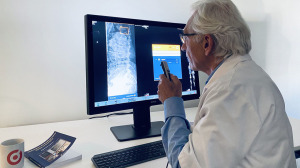by
John R. Fischer, Senior Reporter | May 24, 2022

The BoneView AI software detects fractures in X-rays. (Photo courtesy of Gleamer)
French manufacturer Gleamer has integrated its BoneView solution, designed to identify and localize fractures in X-rays, onto Aidoc’s AI platform.
With more than 152 million exams performed annually, X-ray is the most widely used modality. Because of the high volume of scans it produces, radiologists have the least amount of time to interpret them and the current labor shortage and rising labor costs have only exacerbated the problem.
BoneView has been clinically proven to decrease reading time for appendicular X-rays and to increase sensitivity and specificity in interpretations by 8.7% and 4.1%, respectively, according to Gleamer. Aidoc’s platform deploys AI solutions, including third-party ones, across hospital facilities to address operational challenges, from scan interpretations to IT and scalability issues. The company recently achieved FDA clearance for triage and notification of pneumothoraces in X-rays and says adding Gleamer's technology furthers its presence in the X-ray space.



Ad Statistics
Times Displayed: 123176
Times Visited: 7142 MIT labs, experts in Multi-Vendor component level repair of: MRI Coils, RF amplifiers, Gradient Amplifiers Contrast Media Injectors. System repairs, sub-assembly repairs, component level repairs, refurbish/calibrate. info@mitlabsusa.com/+1 (305) 470-8013
"Given Gleamer's AI solution covers bone fractures across the body including limbs, pelvis, thoracic and lumbar spine and rib cage, it's suitable for nearly half of all X-ray exams coming from emergency rooms and outpatient imaging centers," Tom Valent, VP of business development for Aidoc, told HCB News.
BoneView is FDA cleared as a CADe/CADx (computer-assisted detection and diagnosis) tool that works by creating bounded boxes around the suspected location of fractures. It then alerts radiologists of critical cases so they can prioritize reading. In a study by Boston University School of Medicine, specialists found that the solution, combined with their interpretations, reduced false negatives by 29% and reading time by 15%.
It can be used by radiologists, orthopedic surgeons, emergency physicians, rheumatologists, family physicians and physician assistants. It also is CE marked. "Considering the existing fatigue and shortages experienced in the U.S., and that fracture interpretation errors can represent up to 24% of harmful diagnostic errors seen in the ER, we anticipate that the integration will benefit health systems looking to improve imaging efficiency across all their facilities," said Gleamer CEO and co-founder Christian Allouche in a statement.
BoneView will be among 13 other AI applications available on Aidoc's platform, which is used by more than 900 hospitals. The companies expect both their technologies together will reduce turnaround time and improve patient outcomes.
Back to HCB News

